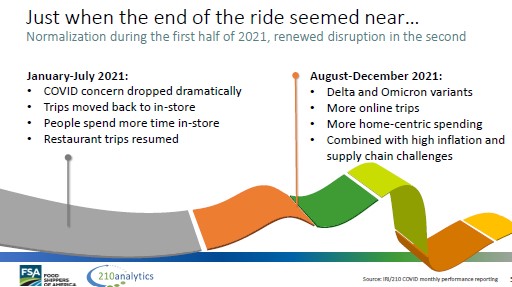ReThink Everything: Because Change is the Only Constant
by Staff, on Feb 21, 2022 5:28:06 PM

The food industry has been in flux for years, as buying power shifted from Boomers to Millennials. Clear trends such as healthy living, sustainability, technology and convenience have been dramatically changing how, where and when shippers spend their money.
But retail change quickly changes with the arrival of the COVID-19 pandemic, and there were several containment measures that drastically changed everything. Consumers shopped different stores, bought different items, and began preparing more meals at home. Consumers quickly realized every link in the food supply chain is essential.
What Forces Have Accelerated Changes?
There are numerous forces at play, although the pandemic has added fuel to quite a few of them. These include:
Changing consumer preferences.
More than ever, consumers are health-conscious and looking for fresh, additive-free food with traceable origins, with an increasing preference for local, according to a recent Forbes article on Ways that COVID has changed the way we eat.
Changing trade conditions.
As global trade wars continue and ensuing political tensions rise, COVID-19 and related containment measures are putting the brakes on international trade, according to a Forbes article particularly citing the trade tensions between the U.S. and China. This will have an increasing impact on food shippers – particularly those that are super-regional or global in scope of operation and market reach.
Tightening rules and standards.
Food safety concerns are expected to further heighten in the wake of the pandemic, leading to even more regulatory pressure.
Demographic and social changes.
While growing populations and middle classes will remain a theme, new social patterns are likely to emerge in the post-outbreak era, such as a decrease in globalization, as regional and local products capture a bigger share in production and consumption.
Rapid technological advances.
IT innovations are improving not just efficiency and sustainability, but also supply chain visibility - particularly vital now to spot and address supply chain issues in an early stage.

Food Shippers: Highlighted Trends to Focus On
During the recent 2022 Food Shippers Conference in Orlando, Fla., speaker Anne-Marie Roerink of 210 Analytics, shared specific trends that food company should be aware of. Specializing in quantitative and qualitative research in several industries including food, Roerink served as the Director of Research for the Food Marketing Institute (FMI). Responsible for all research projects, she distilled complex research data into usable and easy-to-understand materials for business audiences ranging from America’s largest retail chains to single-store family companies. Studies and presentations she has been involved in include shopper insights, retailer benchmarking and trending in financial, and operational and tactical areas.
Roerink identified these 9 trends for food shippers to be aware of that likely will have a significant impact on their business strategy and supply chain operations:
- COVID will continue to have a firm grip on how and where food dollars are spent.
- Retail still has a majority share of dollars, but food service recovery is ongoing.
- Spending and distribution will grow more splintered with many new channels/formats.
- Inflation and supply chain challenges will continue to impact purchase decisions.
- Expect a greater emphasis on carbon footprint and net zero carbon efforts.
- Continued pull between fresh and frozen in retail and foodservice.
- Demographic shifts will impact shipping routes and needs.
- Micro-fulfillment and last mile will take on an even bigger role.
- Labor issues will accelerate technology integration throughout the supply chain.
Smart food shippers will continue to assess and understand the forces that are accelerating change in their enterprises and the trends that will have a dramatic impact on their food supply chains. “Trends from convenience to sustainability will continue to change the food landscape,” concludes Roerink.
Like this kind of content? Subscribe to our "Food For Thought" eNewsletter!
Now more than ever, professionals consume info on the go. Distributed twice monthly, our "Food For Thought" e-newsletter allows readers to stay informed about timely and relevant industry topics and FSA news whether they're in the office or on the road. Topics range from capacity, rates and supply chain disruption to multimodal transportation strategy, leveraging technology, and talent management and retention. Learn More



